Technical tables and repertories
Musical extension table for accordion reeds
The table allows you to identify each note of the equal tempered scale, specifying its position in the octaves and in the stave, its frequency (440), and the unique identification number of the note adopted in our technical documentation, which appears in the rows headed "Note ID".
We recommend always using this identification number (Note ID) associated with the name of the note (A or LA) to minimise the risk of errors or misunderstandings. For example, the middle A/LA note at the 4th octave (A4), whose frequency is 440 Hz, has the number 24 as its identifier, and is written A24 or LA24.
The number in brackets next to the octave designations identifies the octave, according to another coding system which is alternative to the use of apostrophes and lower or upper case note letters. For example: a’’ = A2 (corresponds to LA36); a’ = A1 (corresponds to LA24, the middle LA, in the 4th octave); a = A0 (corresponds to LA12); A = A-1 (corresponds to LA012); A = A-2 (corresponds to LA0012). We recommend using this coding only to identify our identification number (Note ID), not as a criterion in the exchange of information.
Musical extension table of chromatic scale reeds with relative plates
The table allows you to identify each note of the equal tempered scale, specifying its position in the octaves and in the stave, its frequency (440), and the unique identification number of the note adopted in our technical documentation, which appears in the rows headed "Note ID".
We recommend always using this identification number (Note ID) associated with the name of the note (A or LA) to minimise the risk of errors or misunderstandings. For example, the middle A/LA note at the 4th octave (A4), whose frequency is 440 Hz, has the number 24 as its identifier, and is written A24 or LA24.
The number in brackets next to the octave designations identifies the octave, according to another coding system which is alternative to the use of apostrophes and lower or upper case note letters. For example: a’’ = A2 (corresponds to LA36); a’ = A1 (corresponds to LA24, the middle LA, in the 4th octave); a = A0 (corresponds to LA12); A = A-1 (corresponds to LA012); A = A-2 (corresponds to LA0012). We recommend using this coding only to identify our identification number (Note ID), not as a criterion in the exchange of information.
In this table, each note is associated with the identification number of the plate used in the reed (Plate ID). From the plate identification number, using the following table, it is possible to know the outer dimensions of the reed and bass plates for the measurements of the reed block cells for chromatic scale reeds.
Table of reed plate outer dimensions
On this sheet for each high and low reed, the measurements in millimetres of the outer dimensions of the plate are expressed: width, length and thickness.
Table of bass and terzet plate outer dimensions
In addition to the outer dimensions of the basses used on chromatic accordions, this sheet also shows the outer dimensions of the Helikon basses in our range, in the available formats, used on Styrian harmonicas.


